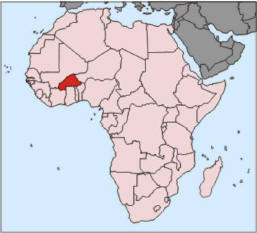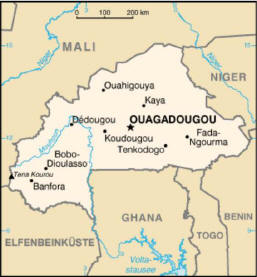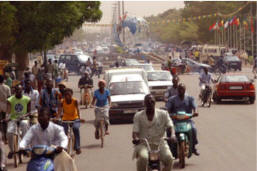|
|
||
|
Burkina Faso |
||
|
Republic of Burkina Faso
Nature
Climate |
 Burkina Faso is situated in West Africa Burkina Faso is 274.000 km² |
|
|
The duration of the rain period and the frequency and amount of rain decreases from south to north: in the southwest from 1.000 to 1.300 mm, in the center 500 to 1.000 mm and in the northeast only very little rainfall. Especially in the Northeast the amount of rain varies considerably. Cultivating farmland becomes more difficult and even without droughts food shortages are possible. |
||
|
State and population The population consists of 60 ethnical groups, the largest group being the Mossi with nearly 50%. The majority of the population is made up of subsistence farmers, i.e. the harvested crops are mostly for consumption by the farmers themselves. They basically grow millet and sorghum. More than 60% of the population have to live on less than 1 USD per day.
Development chances With these preconditions the country only has little chance of developing. Burkina Faso is a stagnating LIC (Low Income Country) and will in the long run be stuck in the poverty trap – strong population growth and destruction of natural resources.
Economic growth at the expense of an environment essentially necessary
for survival |
||
|
Only little chances for the young people Especially in towns the group of unsatisfied people is increasing and is easily susceptible to simple explanations, concepts of someone or something that evokes feelings of hatred and fear, hatred and violence. Young people (males) without any perspectives are the ideal basis for violence and fights that can even result in a civil war (see Liberia, Sierra Leone, Ivory Coast). |
Ouagadougou is still a peaceful and pulsating city, but the extremely high unemployment rate amongst young people is a huge problem.
|
|
|
International Cooperation
Apart from the bilateral donors (amongst others France, Holland, Germany,
Denmark, Switzerland), the European Union and the World Bank are to biggest
individual donors. |
||
|
|
||

